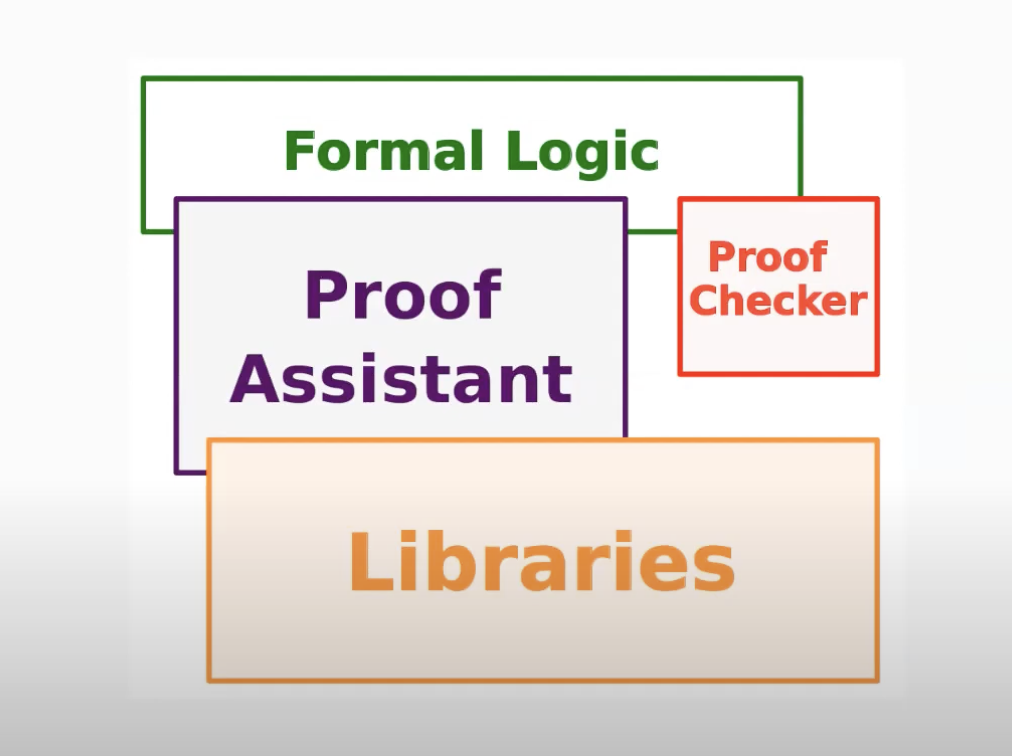Equality
- Equality is a relation between elements of a set.
- Inequality can be defined as the negation of equality.
- Can we supply formal definitions for these concepts?
For instance, we want succ n = n + 1 for natural numbers. How do we define + and check that the former equality holds?
Equivalence relations
We expect the equality relation on a set
- Reflexive, meaning that,
- Symmetric, meaning that,
- Transitive, meaning that,
A binary relation satisfying these properties is called an equivalence relation.
Propositions
Given a set
This does not mean that they represent true statements!
It also does not mean that we can somehow evaluate their "truth value" by applying a "know-it-all" function.
The question is whether we can construct a proof of these propositions.
Propositions as sets
- Propositions, just like sets, may or may not have elements (usually called proofs).
- When we look at an equality between two elements in a set, we ask ourselves: can we construct a proof of
- To answer it, we must provide a formal definition of equality.
Implications and conjunctions
- Let
- In our language, these are defined constructively, just like sets.
- And just like for sets, we must provide rules to construct/introduce proofs.
Implications
Let
- We want
- From the analogy with sets, it means constructing a function from
- So, to prove
Conjunctions
Let
- What does it mean to prove the conjunction
- It is the proposition whose proofs consists are constructed from pairs
inductive And (P Q : Prop) : Prop
| intro (p : P) (q : Q) : And P Q
Example: successor of an even number
Let
- Let
- Indeed, given a
- This suggests that a proof of
Big idea (# 1)
Propositions behave similarly as sets.
- To specify a proposition, we say how its proofs are constructed/introduced.
- We constructions new propositions from old ones using functions, products, and other such rules.
- This is known as the Curry-Howard correspondence or the Brouwer-Heyting-Kolmogorov interpretation.
Negation
Just like for sets, there is an empty proposition called ⊥ (bottom). It is defined by the absence of way to construct proofs of it.
inductive False : Prop
- The negation of a proposition
- To prove
- Can you see why, given a proposition
Denial inequality
- If we have an equality relation
- Do we have
Possible project: the natural numbers
- Injectivity of
Nat.succand proof that,∀ n : ℕ, 0 ≠ succ n. - Definition and properties of addition and multiplication of natural numbers.
Proofs of equality
- It is difficult to define equality, i.e. to give rules for how to prove an equality.
- In 1973, Martin-Löf proposed to define equality inductively, with reflexivity as the only way to construct a proof:
Symmetry and transitivity of equality then follow from reflexivity, by induction. - In Martin-Löf's approach, equality is no longer observed, it is carried. Frege conceptualizes this difference using the words Bedeutung and Sinn (1892).
Congruence and transport (substitution)
- The following properties of equality are also proved by induction.
- If
- Given a family of propositions
Martin-Löf's constructive mathematics
- A constructive proof is a algorithmic in nature. It can, in principle, be converted into a computer program.
- The fact that the program typechecks is a proof that the algorihtm is correct, meaning that it meets its specification.
- This is the reason why type theory is the theoretical foundation of modern functional programming languages, and why these can be used as proof assistants.
Structure of an interactive theorem prover

Image credits: Assia Mahboubi.
Disjunction
Let
- What does it mean to construct a proof of
- By definition, it means providing either a proof of
inductive Or (P Q : Prop) : Prop
| inl (p : P) : Or P Q
| inr (q : Q) : Or P Q
- This means that there are two ways of constructing a proof of
Tautologies
A tautology is a proposition which is built up from older ones and which has a proof regardless of whether the old ones do. For instance:
Possible project: Propositional calculus
- Prove the previous tautologies.
- Prove De Morgan's first law:
- Prove the implication:
Here,
Existential statements
- What does it mean to prove that
- By definition, it means to provide a pair
inductive Exists (P : X → Prop) : Prop
| intro (x : X) (p : P x) : Exists P
- So, formally, proofs of an existential statement
Constructive proofs of existence
- Let
- This is classical reasoning: we are assuming that we can prove
Universal statements
Proofs of universal statements are somewhat trickier.
- Let for instance
- But what does it mean to provide a proof of
- For
Big idea (# 2)
Mathematical logic is not a pre-requisite of our language. Instead, logical connectives and quantifiers are introduced in the same way as sets.
Decidability
- We will be particularly interested in sets with decidable equality, i.e. sets
where - More generally, a proposition
- Sets with decidable equality are sometimes called discrete sets. If we accept the LEM, then all sets are discrete (
).
Possible project: Sets and subsets
- Show that the set of natural numbers has decidable equality.
- Given a set
- Let
- Show that if, for all
Uses of decidability
The equivalences in
- If
- If
- If
- If
- If
In
Possible project: Predicate calculus
Let
- Prove the equivalence
- Find decidability conditions under which we can prove the equivalence
- How about
As an example, think of the statement that, given an ideal